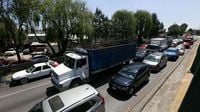The fourth Saturday of the "Hoy No Circula" program in Mexico City and the State of Mexico took place on March 22, 2025, amidst ongoing concerns about air quality and environmental contingencies. Car owners were left wondering about the restrictions in place due to the fluctuating ozone levels in the region.
On the previous Wednesday, March 19, 2025, the "Doble No Circula" was activated as a response to a Phase 1 Environmental Contingency for ozone. However, by the end of that same day, the measure was suspended. Despite these precautionary steps, air quality remained a pressing issue, as reports indicated varying levels of air quality across regions.
As of March 21, 2025, air quality readings in the Valley of Mexico were reported as poor in several locations including Tláhuac, Atizapán, Cuautitlán Izcalli, Naucalpan, and Tlalnepantla, with areas like Álvaro Obregón, Azcapotzalco, Coyoacán, and Gustavo A. Madero deemed as acceptable. Responding to these conditions, health authorities advised vulnerable groups to limit outdoor exertions and stay updated on official announcements regarding air quality and traffic restrictions.
For March 22, 2025, there was no announcement from the Commission for the Environment of the Megalopolis (CAMe) regarding a reactivation of the environmental contingency, allowing for the standard operation of the "Hoy No Circula" program, which runs from 5 AM to 10 PM. The vehicles affected on this day included those bearing hologram 1 and those with even-numbered license plates ending in 0, 2, 4, 6, 8, as well as all vehicles with hologram 2.
The "Hoy No Circula" program plays a critical role in managing vehicle circulation in the 16 boroughs of Mexico City and 18 municipalities in the State of Mexico, including Atizapán de Zaragoza, Coacalco, and Cuautitlán. It is designed to mitigate traffic congestion and improve air quality in the region, particularly during periods of high ozone concentrations.
Well, for drivers wondering which vehicles are exempt from the circulation restrictions, various categories are eligible. These include vehicles with holograms zero and double zero, tractors, construction machinery, motorcycles, electric cars, hybrid vehicles, urban service vehicles for emergency services, and others designated for public health, safety, and public transport. Taxis, too, are allowed to operate during restricted hours to facilitate mobility.
Thus, this Saturday, March 22, drivers with hologram 1 and odd-numbered license plate endings—such as 1, 3, 5, 7, and 9—could circulate freely without concerns. Provisional circulation permits, however, face strict limitations. They cannot operate on Fridays, from 5 AM to 10 PM, and must also refrain from driving every Saturday during the same times, along with restrictions from Monday to Thursday during morning hours.
Despite the cancellation of the "Doble Hoy No Circula" for this date, residents and commuters were advised to keep an eye on updates from CAMe regarding any potential rapid changes in air quality or the reactivation of contingency measures. This vigilance reflects the ongoing struggle to balance urban mobility with environmental health standards in the populous region.
To summarize, as it stands on March 22, 2025, there were no additional restrictions imposed for the "Hoy No Circula" program, allowing many vehicles—including exempt ones—to operate as normal across the Mexico City metropolitan area. It is a situation that will continue to unfold, especially as the region aims for improvements in air quality in the face of environmental challenges.





